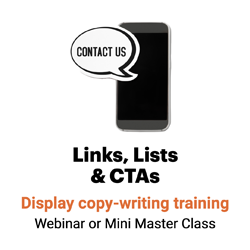They attract attention, make messages memorable
Pull quotes — aka callouts, breakout quotes or pullout quotes — are “the print equivalent of a sound bite,” according to the authors of The Newsletter Editor’s Desk Book

Actually, I think they’re more like movie trailers. They show just enough of the best stuff to entice readers to buy a ticket for the full show.
And that’s the power of a provocative pull quote. If it’s juicy enough, it can convince someone who’s already decided to skip the story to give it another chance.
Pull quotes increase reading and more.
Why callouts? Because they:
1. Increase reading
In 2004, two Swedish researchers used an eyetracking lab to find out how readers view elements like callouts. After tracking 26 readers as they viewed 34 Nordic newspaper pages, the researchers found that pull quotes pull readers into the article. Specifically, readers:
- Viewed stories with callouts before those without
- Read the callouts, usually right after they read the headline
2. Boost communication
In a survey of academic research on pull quotes, two professors at the School of Journalism and Mass Communication at the University of North Carolina at Chapel Hill report that readers:
- Better understand the important parts of a story when pull quotes draw their attention to important information
- Are persuaded by the viewpoints represented in the callouts
- Remember more information from vehicles that use more callouts
- Find channels more enjoyable and readable if they use more callouts
Plus, pull quotes make messages more memorable, according to David Ogilvy’s research. “They are above average in recall tests,” he wrote in Ogilvy on Advertising.
3. Multiply clicks
One blogger saw 800 clicks on a single tweetable quote, reports Kevin Lee of Fast Company
4. Make your message look easier to read
Pull quotes break up the text, providing visual relief. And if it looks easier to read, more people will read it.
How to write an effective pull quote
To make the most of this power point on your page:
1. Choose the most provocative point in the story.
What’s your movie trailer? What’s going to transform committed nonreaders into readers?
When my team writes these design elements for our health care system clients, we don’t focus on the moment Grandpa came home well. Instead, we focus on the most dire moment in Grandpa’s illness:
“It felt like somebody stuck a knife in me and kept turning it.”
Remember: Your callout doesn’t have to be a quote. If it’s not, drop the quotations marks.
2. Use “tweetables.”
Tools like ClickToTweet present important quotes visually and increase clicks and shares.
3. Keep the pull quote in context.
Callouts carry persuasive weight, so make sure they reflect the point you’re trying to make.
4. Place pull quotes carefully.
To avoid frustrating readers looking for the quote in the text, place these graphic elements:
- Near the quote in the text
- Before the quote appears in the in text
- In the same order that the quotes appear in the text
“The goal is to draw readers into your pages and to sell them on what’s ahead,” writes John Brady, “not to make them feel like they are watching a re-run.”
5. Keep pull quotes short.
Limit it to 10 to 20 words or two to four lines. Even better: Bring it in at under 280 characters to encourage tweeting.
“The long-winded pull quote is more likely to turn off readers than sell them on the story,” Brady writes. “Short quotes often look like an eye chart when they dribble down a page; long quotes create a dense-pack look after four lines. In both instances, readability is endangered.”
6. Don’t reveal the ending.
“Pull quotes that give away the ending are counterproductive,” Brady writes. “As editorial marketing devices, pullquotes are intended to keep the reader in the story right to the last paragraph. Most readers still like to believe in Santa’s clauses. They want to discover what’s under the editorial tree for themselves.”
Finally, don’t drop the pull quotes. These power tools are far too valuable for communicators to ignore.
___
Sources: John Brady, “The Power of Pull Quotes,” Folio:, Nov.1, 2005
Jana Holsanova and Kenneth Holmqvist, “Looking at the Net News: Eye Tracking Study of Net Paper Reading,” Mediekulturer (Stockholm), 2004, pp. 216-48
Rhonda Gibson, Joe Bob Hester and Shannon Stewart, “Pull Quotes Shape Reader Perceptions of News Stories,” Newspaper Research Journal, March 22, 2001

Leave a Reply